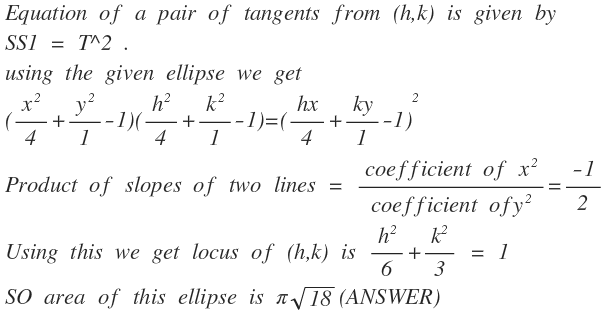Ellipse and Tangentials
Here is an ellipse
4
x
2
+
y
2
=
1
. When the product of slopes of the 2 tangentials to the ellipse from point
P
is
−
2
1
, let the area of region enclosed by
P
's trace be
k
π
.
Find
k
.
The answer is 18.
This section requires Javascript.
You are seeing this because something didn't load right. We suggest you, (a) try
refreshing the page, (b) enabling javascript if it is disabled on your browser and,
finally, (c)
loading the
non-javascript version of this page
. We're sorry about the hassle.
3 solutions
Relevant wiki: Ellipse
Best solution will be the way we find the locus of director circle.
Here we go.
We know that equation of tangent an ellipse is y = m x + a 2 m 2 + b 2
Putting the given values of a and b, we have
y = m x + 4 m 2 + 1
⟹ y − m x = 4 m 2 + 1
⟹ ( y − m x ) 2 = 4 m 2 + 1
⟹ y 2 + m 2 x 2 − 2 m x y = 4 m 2 + 1
⟹ m 2 ( x 2 − 4 ) − 2 m x y + ( y 2 − 1 ) = 0
So we can write m 1 m 2 = 2 − 1
⟹ x 2 − 4 y 2 − 1 = 2 − 1
⟹ 2 y 2 + x 2 = 6
Now lenght of semi major axis for this ellipse is = 2 3
Lenght of semi minor axis = 4 3
⟹ A = π a b
⟹ A = π 1 8
⟹ k = 1 8

Let me propose a problem.
Q. When the product of the slopes of 2 tangential on the ellipse a 2 x 2 + b 2 y 2 = 1 from dot P ( p , q ) outside of the curve is α , equate α using a , b , p , and q .
|Solution|
We can think of the circle x 2 + y 2 = a 2 , made by multiplying b a on y -coordinate.
Multiply b a on the y -coordinate of dot P , and define a new dot P ′ ( p , b a q ) .
The tangential on the circle x 2 + y 2 = a 2 from dot P ’ is y = m ( x − p ) + b a q .
The distance from zero point to the dot of contact d is equal to a , so d = m 2 + 1 ∣ − m p + b a q ∣ = a .
Simplified, a 2 m 2 + a 2 = m 2 p 2 − b 2 m a p q + b 2 a 2 q 2 , m 2 ( p 2 − a 2 ) − b 2 m a p q + ( b a ) 2 ( q 2 − b 2 ) = 0 .
This is the quadratic equation on m , and the product of every possible m is ( b a ) 2 ( p 2 − a 2 q 2 − b 2 ) .
Since we’d multiplied b a on the y -coordinate, product of the 2 slopes of the tangential on the circle x 2 + y 2 = a 2 from dot P ’ is ( b a ) 2 α .
Thus, α = p 2 − a 2 q 2 − b 2 .
|Application|
Since α p 2 − α a 2 = q 2 − b 2 , α p 2 − q 2 = α a 2 − b 2 , trace of dot P ( p , q ) is the quadratic curves.
We need only to observe when α = − 2 1 .
Since p 2 − a 2 = 2 b 2 − 2 q 2 , p 2 + 2 q 2 = a 2 + 2 b 2 , the trace of the dot P is an ellipse of which the center is the dot O ( 0 , 0 ) .
In this case, a 2 + 2 b 2 = 6 , and thus the dot P moves along the ellipse 6 x 2 + 3 y 2 = 1 . Therefore, the area enclosed by P 's trace is 1 8 π , and the value of k is 1 8 .
P.S. Also try my another problem 'Ellipse and the Right Angle'.